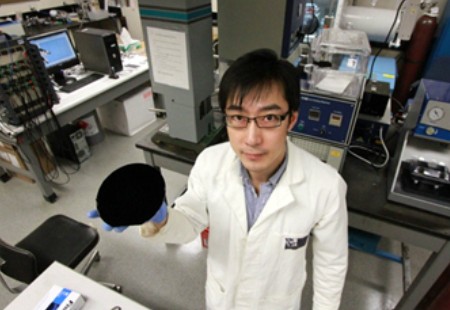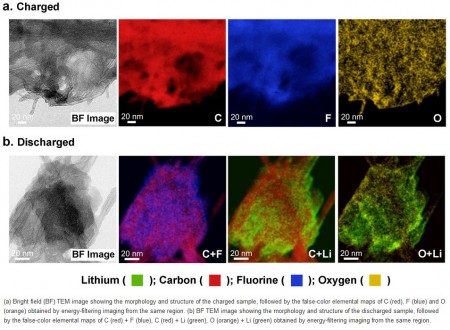Jul
8
The new and now rechargeable Lithium Carbon battery with this dual element storage mechanism of Lithium and Carbon induced with Fluorine (Li-CF) demonstrated a maximum discharging capacity of 2174 mAh g carbon−1 and a specific energy of 4113 Wh kg carbon−1 with good cycling performance. These are very very good starting numbers. Li-CF batteries have the highest energy density among all primary lithium batteries with a theoretical specific energy of 2180 Wh kg−1.

Lithium Carbon Battery Component by Xinwei Cui. Image Credit David Dodge U of A. Click image for the largest view.
Lead researcher Xinwei Cui, PhD a materials engineer at the U of A explains, “What we’ve done is develop a new electrochemistry technology that can provide high energy density and high power density for the next generation. We tried lots of different materials. Normally carbon is used as the anode in lithium ion batteries, but we used carbon as the cathode, and this is used to build a battery with induced fluorination.”
The advantages of using carbon are that it is cost-effective and safe to use, and the energy output is five to eight times higher than lithium ion batteries currently on the market. The new battery also performs better than two other future technologies: Lithium Sulfur batteries, currently in the prototype stage, and Lithium Air batteries, now under development.
A lot of recent work involves Lithium Sulfur and Lithium Air batteries. However, there are some formidable challenges for Lithium Sulfur and Lithium Air batteries such as dissolution of discharging products, poor cathode electrical conductivity, and large volume expansion plus many other nagging issues.
The research team developed the new Lithium Carbon technology for energy storage using carbon in a process called induced fluorination where there’s an induced fluorination of carbon nanotube array paper cathodes, with the source of fluoride ions from electrolytes, by an in-situ electrochemical induction process.

Lithium Carbon Battery Element State Images with Text. Click image for the largest view or click the study paper link below to see the full paper and images.
The advantages of using carbon are that it is cost-effective and safe to use, and the energy output is five to eight times higher than lithium-ion batteries currently on the market. The new battery also performs better than the Lithium Sulfur and Lithium Air batteries. As an example, the induced-fluorination technology could be used to produce cellphone batteries that would charge faster and last longer.
Cui points out what the breakout is from, “Nobody knew that carbon could be used as a cathode with such a high performance. That is what’s unique with our technology and what is detailed in our paper. It wasn’t a quick process. Once we found carbon is different, we persisted for three years until we got results.”
The team published their findings in the journal Nature Scientific Reports, which is in full view that everyone can read. The paper was written by Cui; Jian Chen, a researcher in the National Institute for Nanotechnology; Tianfei Wang, a PhD candidate in materials engineering; and Weixing Chen, professor of chemical and materials engineering at the U of A.
Cui is now chief technology officer at AdvEn Solutions, a technology development company housed within the Department of Chemical and Materials Engineering at the U of A that is working on the battery so it can be commercially manufactured for use in electronic devices.
AdvEn Solutions hopes to have a prototype by the end of 2014 and aims to develop three versions of the battery to serve different goals. One battery would have a high power output and a long life cycle, the second would have high energy for quick charging, and the third a super-high energy storage.
The company recently secured a partnership with the U.S.-based aerospace company Lockheed Martin to develop an advanced anode for AdvEn’s high-performance carbon cathode.
Cui said, “We have a long way to go, but we’re on the right track. It’s exciting work and we want everyone to know about it and that it’s very young but promising.”
With Lockheed Martin along it might not take so long. There’s a “Gigafactory” for batteries getting underway and the battery technology race is going to get nothing but hotter and faster.
Comments
2 Comments so far


I wish these people well. But, I am getting a little skeptical of nano-technology batteries ever being commercially viable. The people at EESTORE were the best example of this problems of scaling up nano-manufacturing to a usable level. It may work great on a nano-level. But, it’s not going to power your car anytime soon.
Well, if it can power cell phone within 2-years period, it would be a great news to the world.
Can’t wait to see further progress.
Congrats!